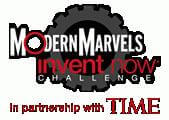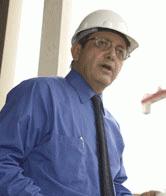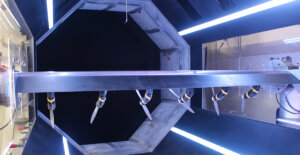ISI’s Behrokh Khoshnevis’s contour crafting process was on display at the California Science Center April 7-14, as part of an exhibit of semifinalists in the Modern Marvels Invent Now Challenge.
Apple Computer founder Steve Wozniak was on hand to officially open the Science Center run of the show April 7. Khoshnevis’ (below) robotic house building process is one of 25 semifinalists in the competition, which takes its name from the long-running program on the History Channel that showcases past inventors and their work
Khoshnevis’ (below) robotic house building process is one of 25 semifinalists in the competition, which takes its name from the long-running program on the History Channel that showcases past inventors and their work

A panel of judges that included inventors, technologists and experts from the National Inventors Hall of Fame and The History Channel selected the semifinalists from nearly 4300 submissions from all over the country.
“These semi-finalists represent the dreamers in America who have the tenacity to pursue their ideas in order to make an impact on the way all of us live-just like their predecessors, Ben Franklin and Thomas Edison,” said Judy Klein-Frimer, Co-Creator of the Challenge for The History Channel.
One of the entries will be named 2006 Marvel of the Year on the history channel Modern Marvels show, which airs Wednesdays at 10 pm. The winner will receive a $25,000 grant. Visitors to the exhibits will have a chance to vote on entries.
After leaving the California Science Center, the exhibit will journey to the Museum of Science and Industry in Chicago (April 20-30th), the Museum of Science in Boston (May 5-14th) and culminate at Vanderbilt Hall in Grand Central Terminal in New York City (May 22-27th). The exposition will then travel to the National Inventors Hall of Fame in Akron, OH where it will be on display through August 2006.
Contour crafting is based on a well-known technology called “rapid prototyping,” also known as “desktop manufacturing,”
In rapid prototyping, machines rather like ink jet printers have heads that spray special plastics rather than ink, which build up three-dimensional structures, layer by layer. But the size of the items “printed out” by the technology is small – 8-12 inches maximum, usually much smaller.
The new process is an ambitious effort to drastically upsize the process to build a full-size house. As Dr. Khoshnevis describes it, rather than a print head spraying ink moving across a piece of paper, a mechanized arm with a nozzle at its end will swing out from supporting machinery on a building site, depositing concrete in a controlled stream to build up a structure.
Besides the History Channel and the National Inventors Hall of Fame Foundation, other sponsors for the competition include TIME Magazine, the United States Patent and Trademark Office, American Society of Civil Engineers, DeLorme Publishing, Inc., Intellectual Property Owners Association and the Licensing Executives Society.
Published on March 24th, 2006
Last updated on August 9th, 2021











